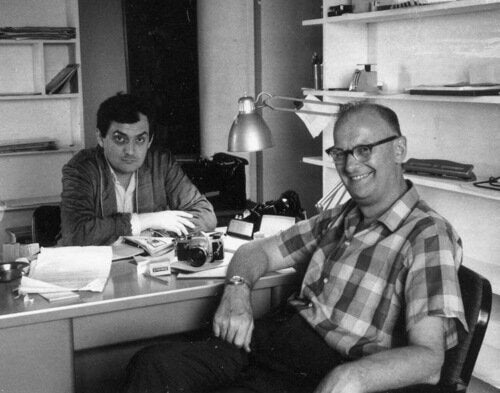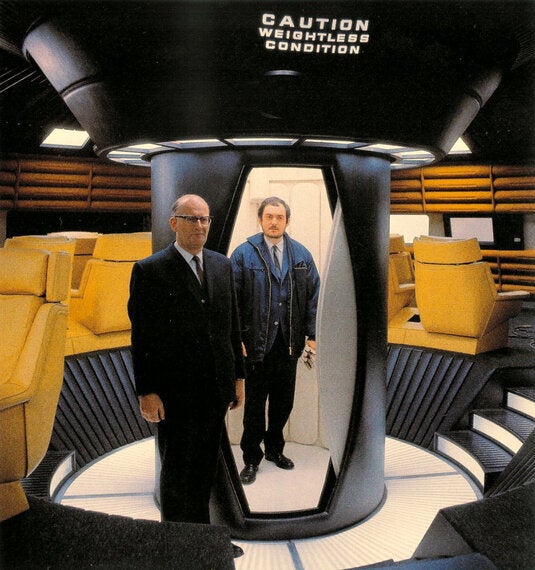
The future isn't going to make itself.
Well, it is advancing, somehow, one second at a time, one trillion of our collective steps or missteps at a time, whether we are deliberate about it or not. But what might it take for us to be radically conscious and active about what's to come? How do we even think about the future? And can we figure out how to think about making the future?
Fifty years ago this week, on April 22, 1964, the future got something of a jump start at Trader Vic's bar at the Plaza Hotel in Manhattan: director Stanley Kubrick and author Arthur C. Clarkemet for the first time to discuss what became 2001: A Space Odyssey, the most visionary and influential science-fiction film of all time.

When it opened four years later, it put on spectacular view not only a startling representation of the future and our possible place in the universe, but also extraordinarily-detailed objects and designs -- from a talking computer to an iPad-type device (cited, unsuccessfully, by Samsung in 2011 as 'prior art' in its defence against an Apple lawsuit), to anti-gravity slippers and (my favourite at the time) really cool explosive bolts.
All science-fiction films are obliged to create props, cityscapes and an array of objects that depict something of their imagined future. But they usually don't feel the same obligation to present them with any scientific credibility. However, Kubrick did.

I spoke recently with the film's scientific advisor, the brilliant space scientist and author Frederick Ordway, who told me that Kubrick wanted to design the film's artifacts based on the best scientific estimates of what technologies would be in place 35 years in the future. What would spaceships actually look like? How would they function and be propelled? How might computer memory be accessed? What text would be seen on monitors? How would astronauts exercise on months-long voyages? (Many of the innovations created for the film by Ordway and his colleagues are meticulously documented in the book 2001: The Lost Science).
If some of the initial critical reactions were mixed (at the Los Angeles premiere, according to Roger Ebert, Rock Hudson "stalked down the aisle, complaining, "Will someone tell me what the hell this is about?''"), 2001 came to be revered and respected as something of a peek into the future of storytelling itself: highly visual, technologically adept, and exhibiting a comfort with sudden and massive leaps in time and space (hmm...internet anyone?). Look magazine praised Kubrick's "bizarre and incisive imagination." It was said that the two collaborators "believe everything will be possible in the next century."
But here we are in that century, the year 2001 well behind us, a year now associated for many not with hope and promise but with tragedy. And with little of 2001's inventions actually in place. Were they wrong, or just 100 years early?
Who cares? It's not about getting it right -- imaginative inventions have aesthetic value in and of themselves.
But there are those working today -- in product design, in universities, in the arts -- whose creations may spark some real futures through design fictions.
In The Fiction of Science Gabriel Nussbaum's short film made for The Future of Storytelling conference in New York in 2013, Google Labs Chief Creative Officer Robert Wong cites the impact Wah Chang, a Chinese-American designer, sculptor, and artist, had on the set of the original 1960s Star Trek TV series, when he was assigned the task of quickly designing and building the handheld communicator device used by Capt.
Kirk and the crew -- it ultimately inspired those working on the first cellphones in the 1970s. Wong's own work -- "an exercise in pretend" as he calls it -- included an ad for a product that didn't quite yet exist. His storytelling "actually helped shape the hard engineered reality" of what became Google Glass.
Design firm IDEO and the MIT Media Lab have collaborated on 'Made in the Future', an experimental project that explores how designers might ultimately create 'Everyday Products With Superpowers.' The project's inspirations include the imagined futures of the past, reminding us that we "may not all have flying cars or intelligent ape chauffeurs today, but so much of what we take for granted -- the Internet, touchscreens, the cubicle -- was once a shiny figment of the future."
In the lobby of the Ontario College of Art and Design in Toronto, there was recently a vending machine with these instructions:
1. Insert coins or bills.
2. Identify your desired item and enter unique selection code.
3. Artifact from the future will be dispensed below.
The contents of the Futurematic Vending Machine (including a nipple-mounted early breast cancer detection device, and a do-it-yourself ecosystem replication kit) were created in a 'speculative design jam' with design collective The Extrapolation Factory and the Situation Lab at OCADU.
Call each of them a Department of Applied Impracticalities, or perhaps the dishevelled and poetic cousins of 'pure research' faculties. But like the dream team of art directors, designers, scientists and technologists assembled and guided by Kubrick to build a seemingly-realistic 2001: A Space Odyssey, such groups have their eye on the very human challenge of solving problems that don't yet exist. The logical HAL 9000 computer from 2001 might not agree, but it won't be computers that will get us there, it'll be human ingenuity.